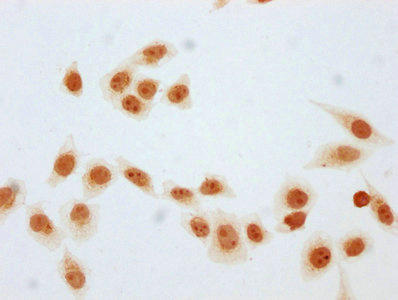Description
beta -hydroxybutyryl-HIST1H1D (K106) Antibody (PACO60592)
The Beta-Hydroxybutyryl-Hist1H1D (K106) Antibody (PAC060592) is a valuable tool for researchers studying histone modifications and their role in gene regulation. This polyclonal antibody, raised in rabbits, is highly specific to the beta-hydroxybutyryl-histone H1D protein and has been validated for use in various applications, including Western blotting.Histone modifications, such as beta-hydroxybutyrylation, play a crucial role in regulating gene expression and chromatin structure. By targeting the beta-hydroxybutyryl-histone H1D protein, researchers can investigate the impact of this specific modification on gene regulation and cellular processes.
The antibody's high reactivity with human samples makes it a valuable tool for studying epigenetic mechanisms in cancer, developmental biology, and other fields of research.The Beta-Hydroxybutyryl-Hist1H1D (K106) Antibody is a valuable research tool for scientists looking to explore the role of histone modifications in gene regulation and disease processes. Its specificity and sensitivity make it an ideal choice for studying the functions of beta-hydroxybutyrylation in various biological contexts.
| Antibody Name: | ?-hydroxybutyryl-HIST1H1D (K106) Antibody (PACO60592) |
| Antibody SKU: | PACO60592 |
| Size: | 50ul |
| Host Species: | Rabbit |
| Tested Applications: | ELISA, WB, ICC |
| Recommended Dilutions: | ELISA:1:2000-1:10000, WB:1:100-1:1000, ICC:1:10-1:100 |
| Species Reactivity: | Human |
| Immunogen: | Peptide sequence around site of β -hydroxybutyryl-Lys (106) derived from Human Histone H1.3 |
| Form: | Liquid |
| Storage Buffer: | Preservative: 0.03% Proclin 300 Constituents: 50% Glycerol, 0.01M PBS, pH 7.4 |
| Purification Method: | Antigen Affinity Purified |
| Clonality: | Polyclonal |
| Isotype: | IgG |
| Conjugate: | Non-conjugated |
 | Western Blot. Positive WB detected in: Hela whole cell lysate, 293 whole cell lysate, A549 whole cell lysate, HepG2 whole cell lysate. All lanes: HIST1H1D antibody at 1.6µg/ml. Secondary. Goat polyclonal to rabbit IgG at 1/50000 dilution. Predicted band size: 23 kDa. Observed band size: 23 kDa. |
 | Immunocytochemistry analysis of PACO60592 diluted at 1:15 and staining in Hela cells (treated with 50mM sodium 3-hydroxybutyrate for 4h) performed on a Leica BondTM system. The cells were fixed in 4% formaldehyde, permeabilized using 0.2% Triton X-100 and blocked with 10% normal goat serum 30min at RT. Then primary antibody (1% BSA) was incubated at 4°C overnight. The primary is detected by a biotinylated secondary antibody and visualized using an HRP conjugated SP system. |
| Background: | Histone H1 protein binds to linker DNA between nucleosomes forming the macromolecular structure known as the chromatin fiber. Histones H1 are necessary for the condensation of nucleosome chains into higher-order structured fibers. Acts also as a regulator of individual gene transcription through chromatin remodeling, nucleosome spacing and DNA methylation (By similarity). |
| Synonyms: | Histone H1.3 (Histone H1c) (Histone H1s-2), HIST1H1D, H1F3 |
| UniProt Protein Function: | H1D: Histone H1 protein binds to linker DNA between nucleosomes forming the macromolecular structure known as the chromatin fiber. Histones H1 are necessary for the condensation of nucleosome chains into higher-order structured fibers. Acts also as a regulator of individual gene transcription through chromatin remodeling, nucleosome spacing and DNA methylation. Belongs to the histone H1/H5 family. |
| UniProt Protein Details: | Protein type:DNA-binding Chromosomal Location of Human Ortholog: 6p21.3 Cellular Component: nuclear chromatin Molecular Function:chromatin DNA binding |
| NCBI Summary: | Histones are basic nuclear proteins responsible for nucleosome structure of the chromosomal fiber in eukaryotes. Two molecules of each of the four core histones (H2A, H2B, H3, and H4) form an octamer, around which approximately 146 bp of DNA is wrapped in repeating units, called nucleosomes. The linker histone, H1, interacts with linker DNA between nucleosomes and functions in the compaction of chromatin into higher order structures. This gene is intronless and encodes a replication-dependent histone that is a member of the histone H1 family. Transcripts from this gene lack polyA tails but instead contain a palindromic termination element. This gene is found in the large histone gene cluster on chromosome 6. [provided by RefSeq, Aug 2015] |
| UniProt Code: | P16402 |
| NCBI GenInfo Identifier: | 121925 |
| NCBI Gene ID: | 3007 |
| NCBI Accession: | P16402.2 |
| UniProt Secondary Accession: | P16402,Q2M2I2, B2R751, |
| UniProt Related Accession: | P16402 |
| Molecular Weight: | 22,350 Da |
| NCBI Full Name: | Histone H1.3 |
| NCBI Synonym Full Names: | histone cluster 1, H1d |
| NCBI Official Symbol: | HIST1H1D |
| NCBI Official Synonym Symbols: | H1D; H1.3; H1F3; H1s-2 |
| NCBI Protein Information: | histone H1.3 |
| UniProt Protein Name: | Histone H1.3 |
| UniProt Synonym Protein Names: | Histone H1c; Histone H1s-2 |
| UniProt Gene Name: | HIST1H1D |
| UniProt Entry Name: | H13_HUMAN |


















